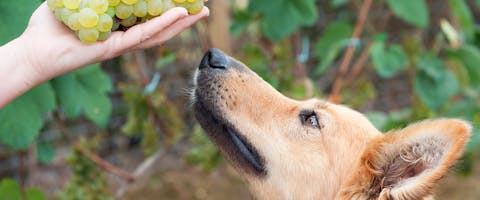As a dog sitter, caring for your new furry pal means more than just cuddles and playtime - it’s about keeping pets safe and sound too. And while some pet care hazards are easy to spot, not all come with a clear warning sign, so here’s a guide to some of the most common dangers and how to steer clear of them when you’re dog sitting.
Food safety
Pet parents should provide you with a feeding plan for their pooch pals, but let’s face it: sometimes things get a bit messy in the kitchen! Before you know it, your four-legged vacuum cleaner may have gobbled something up off the floor they shouldn’t have… here’s a list of foods you should be extra careful with when a pup’s around.
- Chocolate and cocoa powder
- Coffee
- Raisins, grapes, and sultanas
- Rhubarb leaves
- Macadamia nuts
- Garlic and onions
- Alcohol
- Avocados
- Xylitol (found in sugar-free chewing gum and some peanut butter)
- Blue cheese
- Cooked bones
- Mushrooms
- Raw meat or eggs
- Moldy foods
Trending posts
Purr-use some of the top blogs our members have been loving this month- Top male dog names for your new furry friendGot a new furry family member in your pack? Check…

- Top female dog names for your new fluffy palWelcoming a new pooch into your family? Explore…

- 120+ gray cat names your silver feline will loveRecently welcomed a fluffy gray bundle of joy into…

- What are normal pet sitting rates?Discover the average pet sitting rates for animals…

- Unique dog names to stand out from the packDare to be different with our list of the best…

Environmental hazards
Even though most dog-friendly homes are, well, dog-friendly, pet sitters should still be clued up on potential environmental hazards. The following items either shouldn’t be found in the home at all, or must be securely stored out of reach or behind a door with a paw-proof latch.
- Poisonous plants (yucca, umbrella plants, and peace lilies, to name a few - you can visit the ASPCA for a full list).
- Cut flowers including tulips, carnations, daffodils, and chrysanthemums.
- Small chokeable items such as safety pins, hair bands, dental floss, thread, and loose change.
- Batteries, which can cause burns and poisoning if your furry friend decides to chew on them.
- Plastic bags, which can cause asphyxiation.
- Electrical cables - dogs love chewing on things they shouldn’t, and electric cables can give them quite the shock!
- Household goods such as detergents, fabric softeners, and cleaning products that contain toxic chemicals.
- Toothpaste and mouthwash.
- Medication - whether it’s prescribed for the pup or not.
- Some essential oils.
As well as ensuring none of these hazards are within reach of prying paws, it’s important to clear up broken objects (like glass) immediately and turn appliances off after using them. Keep cupboards, windows, and toilet lids closed, and remember to keep furry friends away from areas you’re cleaning and put products out of reach after using them.
Outdoor safety
While it’s a lot harder to manage the risks when you’re out and about, here are a few things to avoid whether your furry friend’s playing in the garden or out on a walk.
- Outdoor plants (including bluebells, rhododendrons, aloe vera, foxgloves, holly, and lily of the valley).
- Pesticides, weed killers, and fertilizers.
- Grass seeds, which can get stuck in a dog’s ear or coat and cause pain or infection.
- Prevent your pooch from drinking water from puddles - they may be contaminated.
Also keep an eye out for extreme weather - high or low temperatures in particular can make pooch pals unwell.
Dog sitting safety tips
If something does go wrong while you’re pet sitting, it’s important to be prepared. Pet parents should provide you with a doggy first aid kit filled with non-stick bandages, medical tape, and an antibiotic spray designed for pups, among other things. You should also be given contact information to use in an emergency, including details of the pet’s regular veterinarian, doggy parents, and a neighbor or friend who lives in the area. Pet owners might also provide you with a phone number for the place they are staying in case you can’t get hold of them directly.
If you suspect your furry friend has come into contact with a hazard, the vet should be your first port of call. This is one of the most important pieces of dog sitting advice, and the more detail you can give the vet, the better - they will then guide you on the next steps, whether it’s rushing in for a check-up or keeping an eye on your pup’s symptoms (in less severe cases).
Caring for someone’s best buddy doesn’t have to be a minefield of worries and “what ifs” with these dog sitting safety tips. Armed with the right knowledge and preparation, your dog sitting adventures will be both safe and fun for you and all the furry friends you meet along the way.

